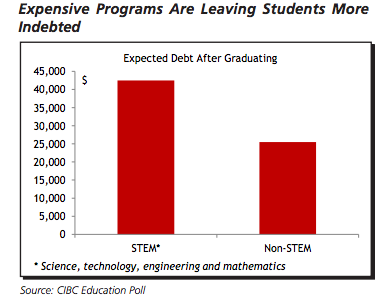Tuition fees across universities and colleges in Canada are continuing to climb, but the biggest fee-increase is taking place in STEM fields — degrees or diplomas in science, tech, engineering and mathematics.A new report by CIBC Capital Markets’ economists Benjamin Tal and Royce Mendes shows that fees in “high-tuition fields”, which tend to be STEM fields, are seeing the fastest price inflation ever — double the pace of what they term “cheaper options”, or rather, degrees and diplomas in humanities and the arts. As is clearly visible in the chart above, STEM graduates leave school with a debt that is significantly higher than non-STEM graduates, by almost $20,000. Of course, one could argue that that works out just fine, since the starting salaries of STEM graduates tend to be higher than non-STEM graduates, with the exception of those who major in business, or law.But here’s the bigger problem — we need more STEM graduates, and high tuition fees are a massive deterrent. “If Canada wants to have more graduates in STEM or any high-paying field, the country needs to work to make it affordable. This type of pricing only exacerbates already ingrained income inequalities across the country,” write Tal and Mendes in the CIBC report.So why exactly is this happening? One theory, according to the authors of the report, is universities capitalizing on increasing enrollment rates of students interested in pursuing STEM degrees.Between the 2007/2008 academic year and the 2014/2015 academic year, enrollment in both business and STEM fields increased by roughly 35 percent. In that same time frame, tuition fees in these programs accelerated.In 2010/2011 for instance, the average cost of an engineering degree in Canada overall was roughly $6,000 per year (this varies according to school and province) — by 2016/2017, an average engineering degree cost over $8,000 per year, essentially a 33 percent increase.Clearly, universities are recognizing increased demand for high-paying fields, and are raising tuition fees sheerly based on this heightened-interest factor.This price appreciation, say Tal and Mendes is dangerous because it can negate the positive effects of having more young Canadians pursuing degrees in STEM fields.“Higher-education is an example of an area that should not be a perfectly free market in which higher demand is wholly reflected in higher prices,”As if to compensate for this phenomenon of skyrocketing fees, the federal government recently announced a $73 million investment in “10,000 paid work placements for students in STEM industries, and the business sector”.The program, will apparently pay companies a certain amount to incentivize the hiring of STEM and business graduates, a move that the government hopes will reduce the lag between students graduating, and getting a job in their field.That’s a step in the right direction, but it will be much more effective if accompanied with a concerted effort to reduce the burden of student debt. After all, if the barriers to entry to pursue a degree in STEM fields continue to soar, any kind of government initiative to get young people into those industries will simply go to waste.Follow Vanmala on Twitter
As is clearly visible in the chart above, STEM graduates leave school with a debt that is significantly higher than non-STEM graduates, by almost $20,000. Of course, one could argue that that works out just fine, since the starting salaries of STEM graduates tend to be higher than non-STEM graduates, with the exception of those who major in business, or law.But here’s the bigger problem — we need more STEM graduates, and high tuition fees are a massive deterrent. “If Canada wants to have more graduates in STEM or any high-paying field, the country needs to work to make it affordable. This type of pricing only exacerbates already ingrained income inequalities across the country,” write Tal and Mendes in the CIBC report.So why exactly is this happening? One theory, according to the authors of the report, is universities capitalizing on increasing enrollment rates of students interested in pursuing STEM degrees.Between the 2007/2008 academic year and the 2014/2015 academic year, enrollment in both business and STEM fields increased by roughly 35 percent. In that same time frame, tuition fees in these programs accelerated.In 2010/2011 for instance, the average cost of an engineering degree in Canada overall was roughly $6,000 per year (this varies according to school and province) — by 2016/2017, an average engineering degree cost over $8,000 per year, essentially a 33 percent increase.Clearly, universities are recognizing increased demand for high-paying fields, and are raising tuition fees sheerly based on this heightened-interest factor.This price appreciation, say Tal and Mendes is dangerous because it can negate the positive effects of having more young Canadians pursuing degrees in STEM fields.“Higher-education is an example of an area that should not be a perfectly free market in which higher demand is wholly reflected in higher prices,”As if to compensate for this phenomenon of skyrocketing fees, the federal government recently announced a $73 million investment in “10,000 paid work placements for students in STEM industries, and the business sector”.The program, will apparently pay companies a certain amount to incentivize the hiring of STEM and business graduates, a move that the government hopes will reduce the lag between students graduating, and getting a job in their field.That’s a step in the right direction, but it will be much more effective if accompanied with a concerted effort to reduce the burden of student debt. After all, if the barriers to entry to pursue a degree in STEM fields continue to soar, any kind of government initiative to get young people into those industries will simply go to waste.Follow Vanmala on Twitter
Advertisement

Advertisement